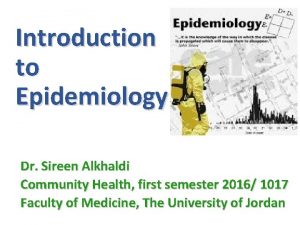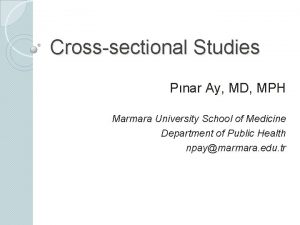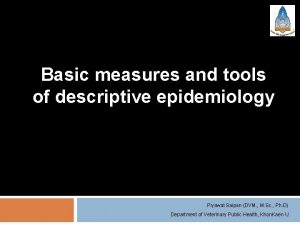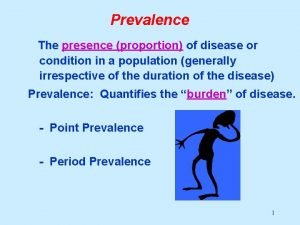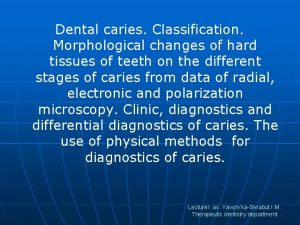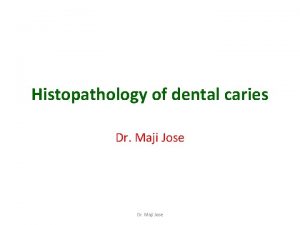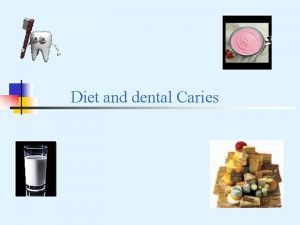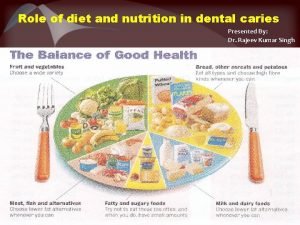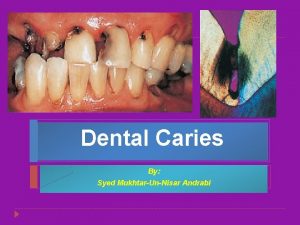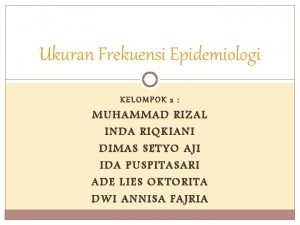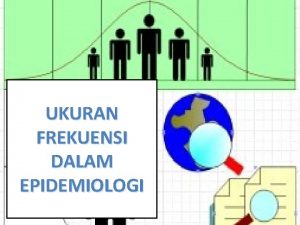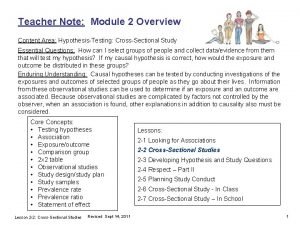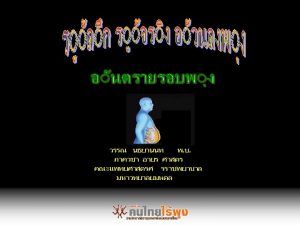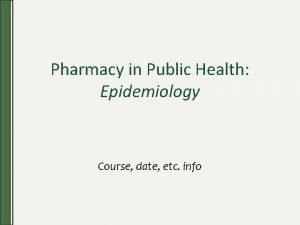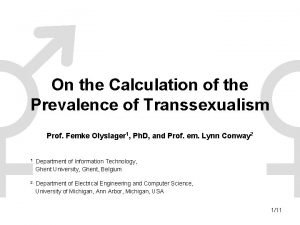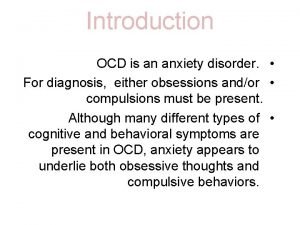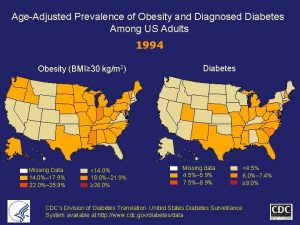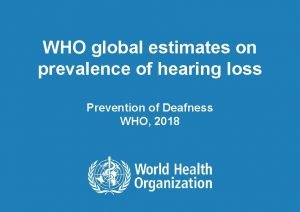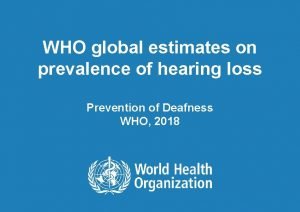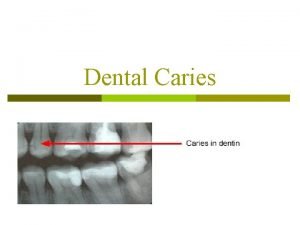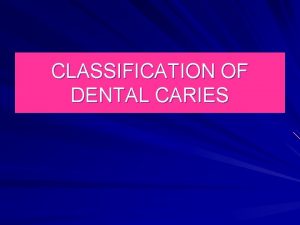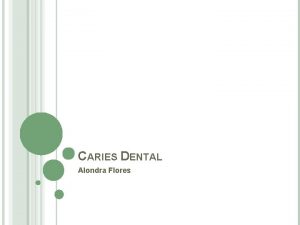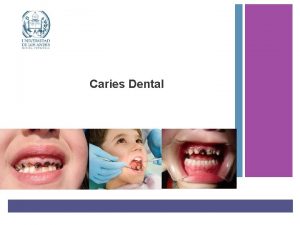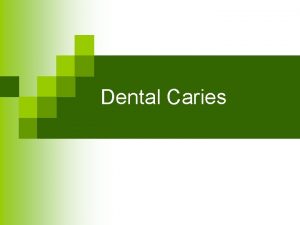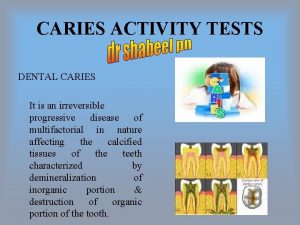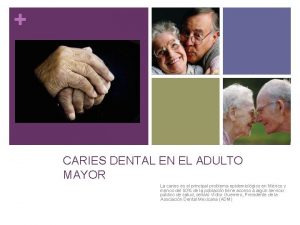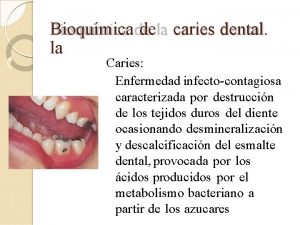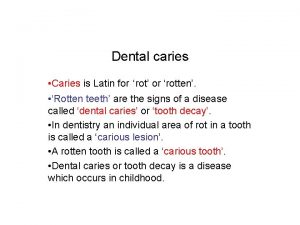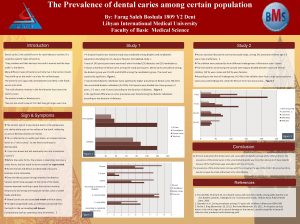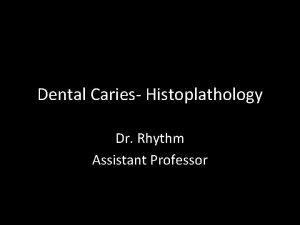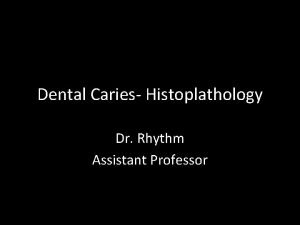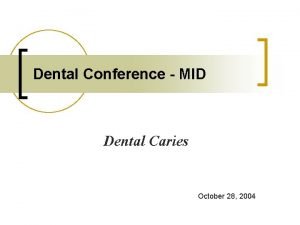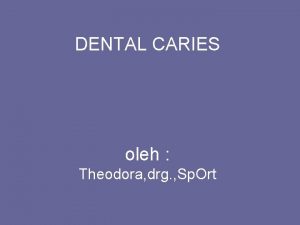Dental caries Determination Epidemiology of caries prevalence and







































- Slides: 39

Dental caries. Determination. Epidemiology of caries: prevalence and intensity of caries, increase of intensity. Etiology and cariogenesis. Modern reasons of origin and theory of development of caries: essence, advantages and failings. Medical University of South Carolina/SC-Geriatric Education Center

Human Teeth with Dental Caries Dental enamel caries Dental enamel demineralization Photo courtesy of DW Sneed, DMD, MAT MUSC College of Dental Medicine Medical University of South Carolina/SC-Geriatric Education Center

Distribution: Dental Caries Age Geographic Gender Race / ethnicity Socioeconomic status Familial patterns Medical University of South Carolina/SC-Geriatric Education Center

BY THE 20 th CENTURY, PATTERN WAS CHANGED o Prevalence and intensity were increased in many developing countries, at least in urban areas Health problem. o marked decrease in caries experience among children and young adults in developed countries. o The declination was less obvious among adults, only new lesions were decrease in smooth surfaces, while pit and fissure lesion is increase. o Evidence supports role of F. Medical University of South Carolina/SC-Geriatric Education Center

Dental caries of permanent teeth: Mandibular first and second molars. Maxillary canines and mandibular first premolars. Maxillary first and second molars. Mandibular centrals, lateral incisors and canines. Mandibular second premolars, maxillary first and second premolars, maxillary centrals and laterals. Medical University of South Carolina/SC-Geriatric Education Center

Close-up Photograph of Root Caries Dental enamel Root surface Root caries Photo courtesy of DW Sneed, DMD, MAT MUSC College of Dental Medicine Medical University of South Carolina/SC-Geriatric Education Center

Indices for dental caries Measurement of intensity of caries For permanent teeth: DMF index D……………. Decayed M ……………. Missed F ……………. . Filled ( DMFT) OR ( DMFS) Medical University of South Carolina/SC-Geriatric Education Center

For primary teeth: def index dmf index df index Medical University of South Carolina/SC-Geriatric Education Center

Number of d + m + f surfaces dmfs Index = —————— Total number of primary teeth Number of d + m + f tooth dmf Index = —————— Total number of primary teeth Medical University of South Carolina/SC-Geriatric Education Center

Calculation of DMFT Medical University of South Carolina/SC-Geriatric Education Center

Table. Level of dental caries intensity (DMFT index) Medical University of South Carolina/SC-Geriatric Education Center

ASSESSMENT OF DENTAL CARIES o Medical University of South Carolina/SC-Geriatric Education Center

Medical University of South Carolina/SC-Geriatric Education Center

Measurement of incidence of caries The incidence of clinical caries in permanent teeth can be determined by conducting two surveys separated by a specified interval of time (usually one year). When age specific DMF rates are used it is possible to estimate the incidence of clinical caries in permanent teeth between any two ages, for example from 6 to 7 years. Medical University of South Carolina/SC-Geriatric Education Center

Distribution: Age o DMF scores increase with increasing age n DMF index is cumulative o (Decayed can become Filled, and then Missing through time) n Whole tooth missing due to dental caries is equal to a count of 4 or 5 surfaces in the DMFS index n Cohort effect Medical University of South Carolina/SC-Geriatric Education Center

Distribution: Gender o Females generally have higher DMF scores n Probable treatment effect o females usually have higher “Filled” component n Earlier tooth eruption among females n Cannot say females are more susceptible to dental caries Medical University of South Carolina/SC-Geriatric Education Center

Average Number of Coronal Caries on Permanent Teeth Surfaces, DMF, Among Dentate Persons by Gender and by Age (years) by Gender Medical University of South Carolina/SC-Geriatric Education Center

Distribution: Race-Ethnicity Little evidence for inherent differences in dental caries susceptibility across race-ethnicity. Differences in socioeconomic status associated with race-ethnicity in the U. S. are probably more important. Medical University of South Carolina/SC-Geriatric Education Center

Distribution: Socioeconomic Status o SES relates to a person’s backgroundvalues Income Education Occupation o Most recent data suggest that DMFS scores are inversely related to SES Medical University of South Carolina/SC-Geriatric Education Center

Distribution : Familial Patterns o “My family has bad teeth” May be a function of n Bacterial transmission n Family habits/ culture o diet o behavioral traits n Genetics (e. g. , salivary flow, composition) o Additional research is needed Medical University of South Carolina/SC-Geriatric Education Center

Determinants: Dental Caries Host (teeth) Substrate (fermentable carbohydrates) Flora (bacteria) Time Medical University of South Carolina/SC-Geriatric Education Center

Diagrammatic representation of interplay between primary and secondary factors in caries aetiology. Medical University of South Carolina/SC-Geriatric Education Center

Determinants: Cariogenicity o ‘Cariogenicity’ is suggested to apply to gramto-gram cariogenic potential for comparisons o ‘Effective cariogenicity’ includes both the gram -to-gram cariogenic potential and the frequency and duration of exposure of the teeth o Fruits, in general, have very low or no cariogenic potential. Medical University of South Carolina/SC-Geriatric Education Center

Figure depicting progression of mineral loss in relation to time Medical University of South Carolina/SC-Geriatric Education Center

Determinants: Diet & Dental Caries 9 o The intake of refined carbohydrates, especially refined sugars, is a risk factor for caries, e. g. , n animal models n human studies o Cooked or milled starches can be broken down by salivary amylase and then serve as a substrate for cariogenic bacteria o Uncooked / lightly cooked vegetables are considered virtually noncariogenic Medical University of South Carolina/SC-Geriatric Education Center

Role of Dietary carbohydrates Fermentable dietary carbohydrates play an important role in causation of caries: Glucose Fructose Sucrose (most potent) etc. These sugars are easily and rapidly fermented by cariogenic bacteria to produce acids at or near the tooth surface & cause dissolution of hydroxyappetite crystals followed by dentin Medical University of South Carolina/SC-Geriatric Education Center

o Rate of caries attack depends on the form of carbohydrate & the frequency of intake of such carbohydrate o Risk of caries increases if sugar is taken repeatedly in between the two major meals o Risk of caries increases greatly if the dietary sugar is sticky in nature which can remain adhered to the tooth surface for a long time Medical University of South Carolina/SC-Geriatric Education Center

Medical University of South Carolina/SC-Geriatric Education Center

Local cariogenic fators Role of micro organisms o Streptococcus mutans plays very role to facilitate in caries formation: It can readily ferment dietary carbohydrate to produce acid It can synthesize dextran from sucrose, the later helps in adhering the bacteria as well as acid on to the tooth surface It has ability to adhere & grow even on hard and smooth surfaces of the teeth Medical University of South Carolina/SC-Geriatric Education Center

o Metabolism of carbohydrate by bacteria produces organic acid which result in highly localized drop in the p. H at plaque- tooth interface A drop in local p. H causes demineralization of tooth surface Below the critical p. H (5. 5) the tooth minerals act as buffers and loose calcium and phosphate ions into the plaque Medical University of South Carolina/SC-Geriatric Education Center

Role of bacterial plaque The plaque is a thin, transparent film produced on tooth surface consisting predominantly of microorganisms suspended in salivary mucins & extra cellular bacterial polysaccharides Also presence of desquamated epithelial cells, leukocytes & food debris, etc. Medical University of South Carolina/SC-Geriatric Education Center

o The dental plaque helps initiation of caries by following ways: It harbors the cariogenic bacteria on the tooth surface It holds the acids on the tooth surface for a long duration It protects the acids produced by the bacteria from getting neutralized Medical University of South Carolina/SC-Geriatric Education Center

Medical University of South Carolina/SC-Geriatric Education Center

Demineralizing/ Remineralizing Cycling Medical University of South Carolina/SC-Geriatric Education Center

A detail of a tooth (to the right = enamel). It is covered by plaque, which consists mainly of bacteria. Plaque is often found close to the gum, in between teeth, in fissures and at other "hidden" sites. Demineralization: When sugar and other fermentable carbohydrates reaches the bacteria, they form acids which start to dissolve the enamel - an early caries lesion occurs due to loss of Calcium and Phosphates Remineralization: When sugar consumption has ceased, saliva can wash away sugars and buffer the acids. Calcium and Phosphates can again enter the tooth. The process is strongly facilitated by fluorides A CAVITY occurs if the Demineralization "wins" over the Remineralization over time Medical University of South Carolina/SC-Geriatric Education Center

Diagrammatic representation of important role of saliva with other primary factors in caries aetiology. Medical University of South Carolina/SC-Geriatric Education Center

NUTRITIONAL MEASURES The chief nutritional measures advocated for the control of dental caries is restriction of refined carbohydrate intake. Other measures include - Avoiding sugar that retains of teeth surface - Avoiding sugar in between meals - Eating of phosphated diets Medical University of South Carolina/SC-Geriatric Education Center

Or an ap ple d en m th i m w o l c a e r e it is ish a m ry n a i v f i l o s a t a s s h c u ot r u o r r s t fib ca n a l A u m i t s Medical University of South Carolina/SC-Geriatric Education Center

Tha nk y atte ou fo r ntio n! Medical University of South Carolina/SC-Geriatric Education Center
 Period prevalence vs point prevalence
Period prevalence vs point prevalence Proportion defination
Proportion defination Period prevalence vs point prevalence
Period prevalence vs point prevalence Period prevalence vs point prevalence
Period prevalence vs point prevalence Prevalensi adalah
Prevalensi adalah Difference between nursing caries and rampant caries
Difference between nursing caries and rampant caries Odontoclasia definition
Odontoclasia definition G j mount classification
G j mount classification Graham mount classification of caries
Graham mount classification of caries Finns modification of cavity preparation
Finns modification of cavity preparation Dentobuff strip system
Dentobuff strip system Zones of enamel caries
Zones of enamel caries Vipeholm study ppt
Vipeholm study ppt Dental caries
Dental caries Turbid dentin in carious tooth
Turbid dentin in carious tooth Prevalence rate formula
Prevalence rate formula Descriptive vs analytic epidemiology examples
Descriptive vs analytic epidemiology examples Difference between descriptive and analytical epidemiology
Difference between descriptive and analytical epidemiology Advantages and disadvantages of nutritional epidemiology
Advantages and disadvantages of nutritional epidemiology Difference between descriptive and analytical epidemiology
Difference between descriptive and analytical epidemiology Certification board of infection control and epidemiology
Certification board of infection control and epidemiology Person place and time model in epidemiology
Person place and time model in epidemiology Attack rate rumus
Attack rate rumus Point prevalence rate adalah
Point prevalence rate adalah Obesity prevalence europe
Obesity prevalence europe Prevalence ratio
Prevalence ratio Prevalence of obesity
Prevalence of obesity Calculate prevalence rate
Calculate prevalence rate Prevalence calculation
Prevalence calculation Prevented fraction
Prevented fraction Ocd vs anxiety
Ocd vs anxiety Incidence vs incidence rate
Incidence vs incidence rate Prevalence of schizophrenia
Prevalence of schizophrenia Cross sectional study
Cross sectional study Calculate prevalence rate
Calculate prevalence rate Ocd vs anxiety
Ocd vs anxiety Age adjusted prevalence
Age adjusted prevalence Mortality formula
Mortality formula Who global estimates on prevalence of hearing loss 2020
Who global estimates on prevalence of hearing loss 2020 Who global estimates on prevalence of hearing loss 2020
Who global estimates on prevalence of hearing loss 2020
